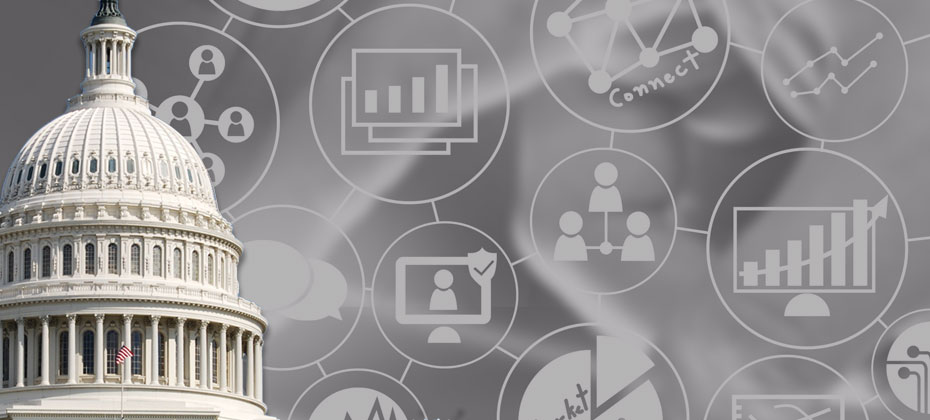Tag: federal policymakers

With jobs losses mounting and the prospects for a quick economic rebound fading, some segments of the financial markets are beginning to bet that the Federal Reserve will take interest rates negative for the first time in U.S. history. If that happens, it could have a profound impact on the U.S. economy, and more specifically, on financial institutions. While other nations such as Denmark, Japan, Sweden, and Switzerland have experimented with negative rates over the years, the U.S. has shied away – both for political and economic reasons. Instead, when interest rates are near zero, the Fed prefers to use a mix of large-scale asset purchases and forward guidance to support the economy. In the current crisis, the Fed has also launched several new emergency lending programs to ensure the smooth functioning of the financial system. The question remains, however, if these tools will be enough to keep the U.S. out of a deep recession, especially if Congress fatigues on further fiscal support. The Fed is independent but keep an eye on the markets In his May 13th remarks to the Peterson Institute for International Economics, Fed Chairman Jerome Powell said that he and the rest of the rate-setting committee unanimously shared the same view on negative rates: “For now, it is not something we are considering”. While some market watchers looked for clues in the “for now” phrasing, it was clear from the rest of his remarks that the bar for enacting negative rates was set very, very high. However, despite the Fed having independence in its policy-making decisions, financial markets and to some extent, politics, still have influence. And there is precedent for markets exerting pressure on the Fed and perhaps even getting their way. In 2013, when then-Fed Chairman Ben Bernanke made a surprise announcement that the Fed would reduce the level of asset purchases, global financial markets went into a frenzy. That period, now known as the “Taper Tantrum”, altered the way the Fed signals its policy actions. More recently, the big declines in equity markets in late 2018 were seen by many as a primary driver in the Fed’s sudden U-turn from raising rates four times that year to lowering them three times in 2019. Now, with equity markets wanting more stimulus and traders in fed fund futures appearing to anticipate negative rates from the central bank in early 2021, there is concern that the markets are trying to bully their way again. And with the president’s renewed call for the Fed to take rates negative, there is some reason to believe that “not now” could become “now” sooner than many expect. Concerns for financial institutions While several central banks have resorted to negative interest rate policy for years, the efficacy of its use is unclear. But what is clear, is that financial institutions bear the greatest burden in implementing the policy. Currently in the U.S., banks earn interest on excess reserves held at the Fed. Negative rates would essentially flip the script and penalize this practice, forcing banks either to pay the Fed interest or do something else with the money. The hope is that this will encourage banks to make more loans and stimulate the economy. However, as Fed Chair Powell said in his remarks, he believes that negative rates could have the opposite effect and curtail lending. Since negative rates would put a downward pressure on interest rates across the board, the net interest margin – the spread banks make between what they pay depositors and what they charge for loans – would be compressed and profitability would sink. If banks and other financial institutions are struggling, credit availability could decline when it is needed the most. Why it matters Financial institutions cannot ignore the possibility of negative interest rates in the U.S. as it would have wide-ranging effects and potentially significant consequences. And while Fed officials have said they are not considering negative rates, the notion is not totally off the table. As the famous economist, Stanley Fischer, advised his fellow central bankers in his well-known piece “Central Bank Lessons from the Global Crisis”: “In a crisis, central bankers (and no doubt other policymakers) will often find themselves deciding to implement policy actions that they never thought they would have to undertake – and these are frequently policy actions that they would prefer not to have to undertake. Hence, a few final words of advice for central bankers: Never say never.”

After two consecutive emergency meetings in March and numerous stimulus announcements, the Federal Open Market Committee (FOMC) finally got back on track and wrapped up their standard two-day meeting on April 29th. While Fed officials did not make any changes to the federal funds rate – which is currently sitting near zero - or to the level of purchases of treasuries and mortgage-backed securities, they did provide a glimpse into how long rates are likely to remain at their current levels. Hint: It is going to be a while. Understanding the Fed’s statement In order to get a clearer picture of what the Fed is thinking, skip the headlines and go straight to the source – the post-meeting press release. Here is the most important paragraph from their statement (with the key components underlined): “The ongoing public health crisis will weigh heavily on economic activity, employment, and inflation in the near term, and poses considerable risks to the economic outlook over the medium term. In light of these developments, the Committee decided to maintain the target range for the federal funds rate at 0 to 1/4 percent. The Committee expects to maintain this target range until it is confident that the economy has weathered recent events and is on track to achieve its maximum employment and price stability goals.” Just by taking the statement at face value, it is clear the Fed is going to keep rates where they are for some time, but for how long? That depends on how the key phrases are interpreted. The first, “over the medium term”, seems simple but requires some detective work. What does “medium term” mean? In the post-meeting press conference, the Fed Chairman was asked this question and he alluded that it likely means a year or more. So, there is part 1 - the Fed expects to keep rates near zero for at least a year. That is not all that surprising, but it does provide a floor: a minimum timeframe. Key phrase 2, however, requires a bit more effort but is where the real story lives. The dual mandate is no longer a balancing act “The Committee expects to maintain this target range until it is confident that the economy has weathered recent events and is on track to achieve its maximum employment and price stability goals.” There is a lot of economics in that sentence. The Fed has been mandated by Congress to achieve two primary goals – maximum employment and price stability (inflation near 2%). These two goals, or the “dual mandate” as they are often referred to, seem simple but have historically been at odds. The thinking went that if the Fed kept interest rates low to support employment, then inflation would rise. And if the Fed increased interest rates to control inflation, then employment would decline. A delicate balance - at least it was thought. Somewhere in the last couple of years Fed officials have realized that even after a decade of near-zero interest rates following the financial crisis and very-low levels of unemployment, inflation has remained persistently below their 2% target. Something has broken in the relationship. This is key, because it means that the Fed now feels free to keep interest rates exceptionally low in order to get employment back on track, without having to worry about inflation; and may in fact need to keep rates lower for longer in order to boost inflation. Both sides of the dual mandate now appear to require low rates. Chasing “maximum employment” With inflation no longer a priority for Fed officials at the moment, their sights are set squarely on achieving the maximum employment portion of the mandate. But what does it mean to achieve “maximum employment”? Well, it is an elusive target, but in general, it is the point at which rising wages leads to higher inflation – the result of businesses increasing pay to compete for a shrinking supply of workers. What is known is that even when the unemployment rate was at a 50-year low of 3.5% in early 2020, wages were not rising much. Which indicates that the economy may have been near maximum employment but was not quite there yet. So, to achieve maximum employment, unemployment needs to be somewhere near 3.5% and that could take some time, a long time. Current range estimates show the unemployment rate rising to anywhere between 12 – 30% in the coming months. And a recent report out of the Congressional Budget Office projected that unemployment will still be around 9.5% at the end of 2021. The last time the unemployment rate was at 9.5% was right after the financial crisis, and from that point it took nearly a decade for the rate to fall to 3.5%. And while it is not expected that the current crisis will be as prolonged as the previous one, it still provides a reference point as to how long it can take to recover job losses. So how long does the Fed expect to keep rates near zero? One year at the very minimum, easily two years, and perhaps up to a decade.

As 2016 comes to a close, many in the financial services industry are trying to assess the impact the Trump administration and Republican controlled Congress will have on regulatory issues. Answers to these questions may be clearer after President-elect Trump is inaugurated on Jan. 20. However, those in the federal regulatory environment are already exploring oversight and regulation of the FinTech and marketplace lending sector. Warning on alternative credit risk models Inquiries by federal and state policymakers over the past year have centered on how FinTech and marketplace lenders are assessing credit risk. In particular, regulators have asked about how credit models different from traditional credit scoring models and what, if any, new attributes or data are being incorporated into credit risk models for consumers and small businesses. On Dec. 2, Federal Reserve Governor Lael Brainard signaled that policymakers continue to be interested in this area during a wide-ranging speech on the potential opportunities and risks associated with FinTech. In particular, Brainard warned that “While nontraditional data may have the potential to help evaluate consumers who lack credit histories, some data may raise consumer protection concerns” and that nontraditional data “… may not necessarily have a broadly agreed upon or empirically established nexus with creditworthiness and may be correlated with characteristics protected by fair lending laws.” Brainard also suggested that there are transparency concerns with alternative scoring models, saying that “alternative credit scoring methods present new challenges that could raise questions of fairness and transparency” given that consumers may not always understand what data is used utilized and how it impacts a consumer’s ability to access credit at an affordable price. Look for regulators and Congress to continue to focus on the fairness and accuracy of new credit risk models and the data underpinning those models in debates surrounding FinTech and Marketplace lending in 2017. A national charter for FinTech? Earlier this month, the Office of the Comptroller of the Currency (OCC) announced that it was considering the creation of a national charter for FinTech lenders. There has long been speculation that the OCC would offer a national charter for FinTech. Analysts have suggested that the creation of a charter could help increase regulatory oversight of the growing market and also provide additional regulatory certainty for the emerging FinTech industry. The OCC’s proposal would create a special purpose national bank charter for FinTech businesses that are engaged in at least one of three core banking activities: receiving deposits; paying checks; or lending money. The OCC will be developing a formal agency policy for evaluating special purpose bank charters for Fintech companies that will designate the specific criteria that companies applying for a charter will have to meet for approval. OCC has suggested that this will likely focus on safety and soundness; financial inclusion; consumer protection; and community reinvestment. The OCC is collecting comments on the proposed policy through Jan. 15, 2017.